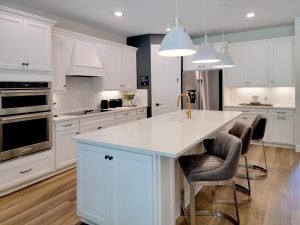Last Updated on November 20, 2025 by teamobn
Contents
Quick Answer
Choosing the right concrete finish means balancing beauty, durability, and practicality. From sleek troweled surfaces to textured broom, stamped, or exposed aggregate designs, each option offers distinct advantages in appearance, traction, and upkeep. Factors such as local climate, foot or vehicle traffic, and your desired maintenance level all play key roles in the decision. By understanding how different finishes perform over time, you can create a driveway or patio that’s visually appealing, safe, and built to last.
Introduction
Concrete is far from one-size-fits-all. The right treatment transforms a plain slab into a durable, visually engaging surface that complements your home’s character. Whether you lean toward clean minimalism or rustic texture, understanding your options early prevents costly regrets down the road. 
For those exploring possibilities, experienced, reputable concretors offer practical insights into how different approaches perform in real-world conditions.
Exploring Different Types of Concrete Finishes
Not all concrete surfaces are created equal. The finish you choose plays a starring role in both form and function – determining how your driveway or patio looks, feels, and performs over time. From utilitarian to ultra-modern, the spectrum of options lets you tailor your outdoor space to match your practical needs and personal taste. Below, we break down the most common and compelling choices, so you can weigh aesthetics against durability with confidence.
Smooth Trowel and Broom
A smooth trowel finish offers a clean, minimalist appearance often seen in modern garages or interior slabs. It’s created by repeatedly smoothing the surface with a steel trowel, resulting in a flat, even plane. While sleek, it can become slippery when wet – making it less ideal for exposed patios or sloped driveways in rainy or icy climates.
In contrast, a broom finish adds subtle texture by dragging a stiff-bristled broom across freshly poured concrete. This creates fine grooves that improve traction and reduce slip risk – a practical choice for high-traffic zones. It’s cost-effective, low-maintenance, and pairs well with both traditional and contemporary homes.
Stamped and Coloured Options
For those craving visual flair without sacrificing strength, stamped concrete mimics the look of stone, brick, or wood through patterned moulds pressed into the surface before it cures. When combined with integral or surface-applied pigments, it delivers rich, custom aesthetics at a fraction of the cost of natural materials.
Modern concrete finishes often lean into this technique, using advanced release agents and staining methods to achieve realistic depth and variation. Keep in mind that stamped surfaces require sealing to preserve colour and resist freeze-thaw damage – especially in regions with harsh winters.
Exposed Aggregate and Polished Surfaces
Exposed aggregate reveals the natural beauty of stones or pebbles embedded in the mix. Achieved by washing away the top layer of cement paste while the slab is still curing, this finish offers excellent grip and a rustic, speckled appearance. It’s highly durable and ideal for driveways that see heavy use.
Polished concrete, on the other hand, involves grinding the surface to a smooth sheen – sometimes to a near-glass finish. While more common indoors, it’s gaining traction outdoors in dry climates or covered patios. It’s easy to clean and reflects light beautifully, though it demands careful maintenance in wet or snowy conditions.
Architectural Concrete for High-End Appeal
An architectural concrete finish elevates outdoor spaces with precision detailing, custom formwork, and refined textures. Often used in luxury builds or commercial settings, it emphasizes clean lines, intentional joints, and monolithic elegance. This approach treats material not as a base material, but as a design feature – ideal for homeowners seeking a gallery-like aesthetic.
While it commands a higher price tag and requires skilled craftsmanship, the result is timeless and low-profile, letting the structure speak for itself.
To help compare your options at a glance, here’s a quick-reference table:Finish Type Best For Traction Maintenance Climate Suitability Smooth Trowel Garages, modern interiors Low Very Low Dry or covered areas Broom Driveways, walkways High Low All climates Stamped & Coloured Patios, decorative zones Medium Medium Moderate; seal in cold Exposed Aggregate High-traffic driveways Very High Low All climates Polished Covered patios, luxury looks Low High Mild or dry climates only Architectural Premium residential projects Varies Low–Medium All (with proper detailing)
Understanding these different types of concrete finishes empowers you to make a choice that balances beauty, safety, and longevity – without over-engineering or overspending.
Practical Tips to Match Finish to Function

Selecting a concrete finish that aligns with real-world use – not just visual appeal – is the difference between satisfaction and second-guessing. The right choice considers how the space will be used, local weather patterns, and long-term care expectations. Below, we break this down into actionable guidance, so your driveway or patio performs as beautifully as it looks.
Assess Your Space’s Primary Use
Start by evaluating how the surface will be used day to day. A driveway that accommodates heavy vehicles or frequent turning needs a durable, impact-resistant finish. In contrast, a backyard patio meant for quiet relaxation can prioritize aesthetics over ruggedness.
- Support heavy or repeated vehicle loads with broom or exposed aggregate/cement finishes.
- Choose slip-resistant textures for areas used by children, seniors, or pets.
- Opt for seamless, low-porosity surfaces if the space doubles as a play or dining zone.
- Avoid deep grooves or joints in areas where wheeled items (strollers, carts) are common.
Factor in Local Climate Conditions
Weather dramatically affects concrete longevity. Freeze-thaw cycles, intense sun, or heavy rainfall each demand specific surface traits to prevent cracking, spalling, or discoloration.
- In cold climates, prioritize finishes that shed water quickly and accept sealers well.
- Hot, sunny regions benefit from lighter-coloured or matte finishes that reflect heat.
- Humid or rainy zones need textured surfaces to minimize standing water and algae growth.
- Coastal areas should avoid finishes prone to salt absorption or efflorescence.
Consider Maintenance Realities
Be honest about how much upkeep you’re willing to commit to. Some finishes look stunning initially but require regular sealing or cleaning to retain their appearance. Others age gracefully with minimal intervention.
- Broom and exposed aggregate finishes typically need only occasional rinsing.
- Stamped or coloured concrete benefits from resealing every 2–3 years.
- Polished surfaces may require specialized cleaners to preserve the sheen.
- Architectural concrete finish details should be inspected periodically for joint integrity.
Align with Your Home’s Design Language
Your outdoor hardscape should feel like a natural extension of your home – not an afterthought. Modern builds often pair well with clean, monolithic surfaces, while heritage homes harmonize with more organic or patterned textures.
A cohesive look doesn’t mean matching materials exactly. Instead, aim for complementary tones, scale, and rhythm. For instance, a smooth broom finish with subtle scoring can echo the lines of a contemporary façade, while a stamped pattern in warm earth tones can soften the transition from a rustic exterior.
Final Thoughts: Make a Choice That Lasts
Selecting the right surface goes beyond trends – it’s about crafting an outdoor foundation that serves your lifestyle for years to come. Whether you lean toward the understated reliability of a broom finish or the refined presence of an architectural concrete one, every option carries trade-offs in texture, upkeep, and resilience. The key is to let function guide form, not the other way around.
Remember, the best-looking driveway or patio is the one that still looks great five winters from now. By matching your choice to real-world demands – traffic patterns, weather exposure, and maintenance comfort – you avoid costly do-overs and enjoy lasting satisfaction.
Take your time, ask questions, and picture your space through all four seasons. The result won’t just be a surface – it’ll be a seamless extension of your home, built to stand the test of time.





